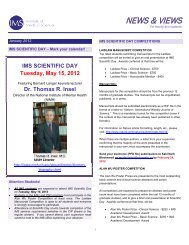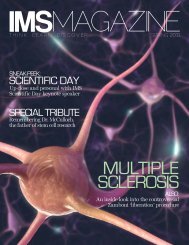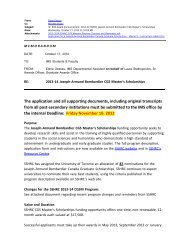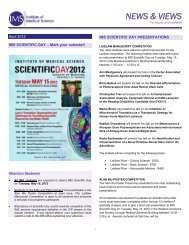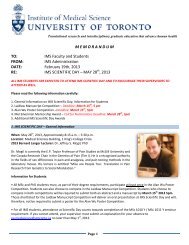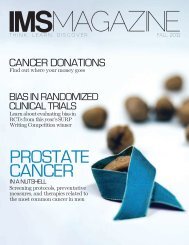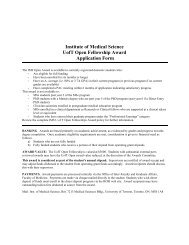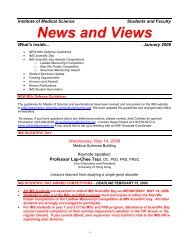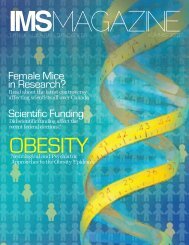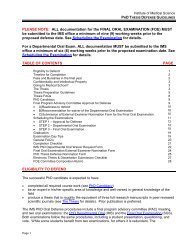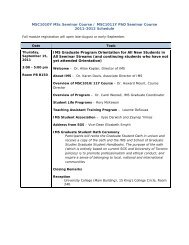IMS Magazine - Summer 2012 edition in PDF format - Institute of ...
IMS Magazine - Summer 2012 edition in PDF format - Institute of ...
IMS Magazine - Summer 2012 edition in PDF format - Institute of ...
You also want an ePaper? Increase the reach of your titles
YUMPU automatically turns print PDFs into web optimized ePapers that Google loves.
CLOSE UP<br />
a PhD under his supervision <strong>in</strong> the area <strong>of</strong><br />
neurotransmitter development and hyperactivity.<br />
Set to undertake a post-doctoral<br />
position at the University <strong>of</strong> M<strong>in</strong>nesota, Dr.<br />
Rem<strong>in</strong>gton had a choice to make: “I was torn<br />
between the basic sciences and do<strong>in</strong>g work at<br />
the cl<strong>in</strong>ical level. I realized that if I wanted to<br />
make a career out <strong>of</strong> this work, I would have<br />
to marry the cl<strong>in</strong>ical with the basic, and to do<br />
so would require a medical degree.”<br />
Hav<strong>in</strong>g completed medical school at McMaster<br />
University, Dr. Rem<strong>in</strong>gton declared a specialty<br />
<strong>in</strong> neurology and began his residency<br />
at the University <strong>of</strong> Western Ontario. A year<br />
<strong>in</strong>to his tra<strong>in</strong><strong>in</strong>g, he was pulled aside by neurologist<br />
Dr. John Brown. “He said I’d make<br />
a better psychiatrist than neurologist,” recalls<br />
Dr. Rem<strong>in</strong>gton. “I called up the Psychiatry<br />
folks <strong>in</strong> Toronto and they accepted me over<br />
the phone.” He then began his psychiatry<br />
residency at CAMH. I ask him about what<br />
would eventually become the focus <strong>of</strong> his<br />
career—schizophrenia—and Dr. Rem<strong>in</strong>gton<br />
says the fasc<strong>in</strong>ation was <strong>in</strong>stant. “I had never<br />
seen anyth<strong>in</strong>g like it, nor have I s<strong>in</strong>ce.” In his<br />
second-to-last year <strong>of</strong> tra<strong>in</strong><strong>in</strong>g, Dr. Rem<strong>in</strong>gton<br />
was approached and <strong>of</strong>fered a staff position<br />
at CAMH; he has now been there almost<br />
thirty years.<br />
When asked to describe his research, Dr.<br />
Rem<strong>in</strong>gton remarks that it is a reflection <strong>of</strong><br />
why he left his post-doctoral position for<br />
medic<strong>in</strong>e. “I feel an obligation to ask a basic<br />
science question that can almost immediately<br />
be translated <strong>in</strong>to changes <strong>in</strong> cl<strong>in</strong>ical<br />
practice,” he cont<strong>in</strong>ues. Strictly speak<strong>in</strong>g,<br />
Dr. Rem<strong>in</strong>gton studies schizophrenia, but<br />
identifies one <strong>of</strong> his shortcom<strong>in</strong>gs as his “<strong>in</strong>ability<br />
to focus on a s<strong>in</strong>gle research question—someth<strong>in</strong>g<br />
that is usually preferred<br />
by scientists.” To illustrate the breadth <strong>of</strong> his<br />
work, Dr. Rem<strong>in</strong>gton and his students study<br />
an array <strong>of</strong> research questions that <strong>in</strong>clude<br />
schizotypy, the metabolic side effects <strong>of</strong> antipsychotic<br />
drugs, antipsychotic tolerance and<br />
adherence, and the manifestations <strong>of</strong> negative<br />
symptoms <strong>of</strong> schizophrenia through virtual<br />
reality techniques.<br />
Given that Dr. Rem<strong>in</strong>gton is be<strong>in</strong>g recognized<br />
for his mentorship abilities, our talk<br />
shifts to students and student supervision. I<br />
ask him how he chooses his students and he<br />
says, “It all depends on the <strong>in</strong>terview. I get a<br />
sense <strong>of</strong> whether or not the fit is right after<br />
speak<strong>in</strong>g to them.” When I ask him to describe<br />
his students, he takes a m<strong>in</strong>ute, a smile<br />
form<strong>in</strong>g on his face, and says his students are<br />
“motivated, able to work <strong>in</strong>dependently, and<br />
hopefully enjoy their research.” He adds, “I<br />
really enjoy the enthusiasm and excitement<br />
my students br<strong>in</strong>g to the laboratory every<br />
day. I rema<strong>in</strong> <strong>in</strong>spired by them.”<br />
“I f<strong>in</strong>d it stimulat<strong>in</strong>g to see the<br />
scope and quality <strong>of</strong> research be<strong>in</strong>g<br />
done by the students at the <strong>IMS</strong>. I<br />
really like see<strong>in</strong>g the passion they<br />
have for their work.”<br />
Dr. Rem<strong>in</strong>gton is known for his eloquence<br />
and candor, so when I ask him about his mentor<strong>in</strong>g<br />
style, I am <strong>in</strong>itially surprised when he<br />
pauses and says, “I don’t know how others<br />
mentor—it’s not like there’s a book for this<br />
sort <strong>of</strong> th<strong>in</strong>g.” He then cont<strong>in</strong>ues, “I mentor<br />
the way I was mentored [by Dr. Anisman]:<br />
I ensure close and regular contact with my<br />
students. I make myself available and try to<br />
provide a supportive environment, giv<strong>in</strong>g my<br />
students the resources they need to succeed.<br />
It’s noth<strong>in</strong>g fancy.” At this last po<strong>in</strong>t I laugh,<br />
know<strong>in</strong>g all too well how rare this situation<br />
can be: Gary Rem<strong>in</strong>gton is an absolutely fantastic<br />
mentor, he pours everyth<strong>in</strong>g <strong>in</strong>to his<br />
students, and they know it. So why does he<br />
do it? “I was there. Somebody did it for me.<br />
Dr. Anisman categorically changed my approach,<br />
not only to medic<strong>in</strong>e, but also to life.<br />
He was amaz<strong>in</strong>g—a role model to me. I feel<br />
I have an obligation to do that for as many<br />
people as possible mov<strong>in</strong>g forward.”<br />
Of the <strong>IMS</strong>, Dr. Rem<strong>in</strong>gton says, “I th<strong>in</strong>k it<br />
has an <strong>in</strong>novative approach to br<strong>in</strong>g<strong>in</strong>g people<br />
together from diverse backgrounds, and<br />
<strong>of</strong>fer<strong>in</strong>g them the opportunity to cross traditional<br />
research boundaries.” He adds that<br />
the challenge rema<strong>in</strong>s <strong>in</strong> “br<strong>in</strong>g<strong>in</strong>g people together<br />
from many areas and levels <strong>of</strong> expertise<br />
<strong>in</strong> an environment that rewards absolute<br />
focus on a s<strong>in</strong>gle area or research question.”<br />
Dr. Rem<strong>in</strong>gton’s <strong>in</strong>volvement <strong>in</strong> the <strong>IMS</strong><br />
doesn’t only <strong>in</strong>clude his role as a graduate<br />
supervisor; he has been on countless Project<br />
Advisory Committees (PACs) and has been<br />
a judge <strong>in</strong> both the <strong>Summer</strong> Undergraduate<br />
Research Program (SURP) and <strong>IMS</strong> Scientific<br />
Days. “I f<strong>in</strong>d it stimulat<strong>in</strong>g to see the<br />
scope and quality <strong>of</strong> research be<strong>in</strong>g done by<br />
the students at the <strong>IMS</strong>. I really like see<strong>in</strong>g<br />
the passion they have for their work.”<br />
I ask Dr. Rem<strong>in</strong>gton what he sees himself<br />
do<strong>in</strong>g <strong>in</strong> ten years: “I hope to still be com<strong>in</strong>g<br />
<strong>in</strong>to work every day. I don’t see what I do as<br />
a job. It’s a well kept secret how much I enjoy<br />
this.” Admitt<strong>in</strong>g that he sleeps about four<br />
hours a night, he adds, “I am blessed with do<strong>in</strong>g<br />
someth<strong>in</strong>g that I love so much and still<br />
want to be do<strong>in</strong>g. I am so lucky—I hope no<br />
one catches on!”<br />
For students, Dr. Rem<strong>in</strong>gton says the largest<br />
obstacle is the “<strong>in</strong>credible competition to<br />
capture a spot <strong>in</strong> this research environment.”<br />
I ask him what is key to select<strong>in</strong>g the right<br />
supervisor, to which he replies, “F<strong>in</strong>d a mentor<br />
as early on as you can. The goal is to f<strong>in</strong>d<br />
someone you respect. Respect is fundamental.”<br />
Dr. Rem<strong>in</strong>gton sees the potential <strong>in</strong> his students<br />
and treats them as valued members <strong>of</strong><br />
the scientific community. His ability to effectively<br />
guide and support his students, while<br />
always rema<strong>in</strong><strong>in</strong>g committed to their success,<br />
makes him the true def<strong>in</strong>ition <strong>of</strong> a mentor.<br />
Although he would never admit to it, I can<br />
th<strong>in</strong>k <strong>of</strong> no one more deserv<strong>in</strong>g <strong>of</strong> the Mel<br />
Silverman Mentorship Award. Congratulations<br />
Dr. Rem<strong>in</strong>gton.<br />
Student sentiments<br />
“Dr. Rem<strong>in</strong>gton is friendly, warm, and encourag<strong>in</strong>g,<br />
while rema<strong>in</strong><strong>in</strong>g entirely pr<strong>of</strong>essional.<br />
He is respectful and sensitive to the<br />
needs <strong>of</strong> his students.”<br />
- George Foussias, MD, PhD candidate<br />
“Dr. Rem<strong>in</strong>gton allows his students to<br />
demonstrate their success, easily stepp<strong>in</strong>g<br />
aside to enable personal growth and accomplishment.”<br />
- Gagan Fervaha, MSc candidate<br />
“Dr. Rem<strong>in</strong>gton sees the potential <strong>in</strong> his<br />
students and treats them as creative, <strong>in</strong>telligent,<br />
and responsible scientists.”<br />
- Laura Schulze, MSc candidate<br />
<strong>IMS</strong> MAGAZINE SUMMER <strong>2012</strong> GENOMIC MEDICINE | 30



